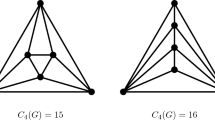Abstract
Counting the number of perfect matchings in graphs is a computationally hard problem. However, in the case of planar graphs, and even for K 3,3-free graphs, the number of perfect matchings can be computed efficiently. The technique to achieve this is to compute a Pfaffian orientation of a graph. In the case of K 5-free graphs, this technique will not work because some K 5-free graphs do not have a Pfaffian orientation. We circumvent this problem and show that the number of perfect matchings in K 5-free graphs can be computed in polynomial time. We also parallelize the sequential algorithm and show that the problem is in TC2. We remark that our results generalize to graphs without singly-crossing minor.










Similar content being viewed by others
References
Barahona, F.: Balancing signed toroidal graphs in polynomial time. Technical report, University of Chile (1983)
Di Battista, G., Tamassia, R.: Incremental planarity testing. In: IEEE Symposium on Foundations of Computer Science (FOCS), pp. 436–441 (1989)
Di Battista, G., Tamassia, R.: On-line maintenance of triconnected components with SPQR-trees. Algorithmica 15(4), 302–318 (1996)
Cayley, A.: Sur les déterminants gauches. J. Pure Appl. Math. 38, 93–96 (1847)
Curticapean, R.: Counting perfect matchings in graphs that exclude a single-crossing minor. arXiv:1406.4056 (2014)
Demaine, E.D., Hajiaghayi, M., Nishimura, N., Ragde, P., Thilikos, D.M.: Approximation algorithms for classes of graphs excluding single-crossing graphs as minors. J. Comput. Syst. Sci. 69(2), 166–195 (2004)
Datta, S., Nimbhorkar, P., Thierauf, T., Wagner, F.: Isomorphism for K 3,3-free and K 5-free graphs is in log-space. In: Proceedings of the 29th Annual Conference on Foundations of Software Technology and Theoretical Computer Science (FSTTCS), pp. 145–156 (2009)
Edmonds, J.: Paths, trees, and flowers. Can. J. Math. 17, 449–467 (1965)
Elberfeld, M., Jakoby, A., Tantau, T.: Logspace versions of the theorems of Bodlaender and Courcelle. In: 51st Annual IEEE Symposium on Foundations of Computer Science (FOCS), pp. 143–152 (2010)
Galbiati, G., Maffioli, F.: On the computation of pfaffians. Discrete Appl. Math. 51(3), 269–275 (1994)
Gibbons, A., Rytter, W.: Efficient Parallel Algorithms. Cambridge University Press, Cambridge (1988)
Harary, F.: Graph Theory. Addison-Wesley, Reading (1969)
Hopcroft, J.E., Tarjan, R.E.: A \(V\log V\) algorithm for isomorphism of triconnected planar graphs. J. Comput. Syst. Sci. 7 (3), 323–331 (1973)
Kasteleyn, P.W.: Graph theory and crystal physics. In: Harary, F. (ed.) Graph Theory and Theoretical Physics, pp 43–110. Academic, New York (1967)
Kulkarni, R., Mahajan, M., Varadarajan, K.: Some perfect matchings and perfect half-integral matchings in NC. Chic. J. Theor. Comput. Sci. 2008(4), 1–26 (2008)
Kuratowski, K.: Sur le probléme des courbes gauches en topologie. Fundam. Math. 15, 271–283 (1930)
Little, C.H.C.: An extension of Kasteleyn’s method of enumerating the 1-factors of planar graphs. In: Holton, D.A. (ed.) Combinatorial Mathematics, volume 403 of Lecture Notes in Mathematics, pp 63–72. Springer, Berlin Heidelberg (1974)
Miller, G.L., Ramachandran, V.: A new graph triconnectivity algorithm and its parallelization. Combinatorica 12, 53–76 (1992)
Mahajan, M., Subramanya, P.R., Vinay, V.: The combinatorial approach yields an NC algorithm for computing Pfaffians. Discrete Appl. Math. 143(1–3), 1–16 (2004)
Robertson, N., Seymour, P.: Excluding a graph with one crossing. In: Graph Structure Theory, pp. 669–675. American Mathematical Society (1993)
Tutte, W.T.: Connectivity in Graphs. University of Toronto Press, Toronto (1966)
Thierauf, T., Wagner, F.: Reachability in K 3,3-free graphs and K 5-free graphs is in unambiguous log-space. Chic. J. Theor. Comput. Sci., To appear (2014)
Valiant, L.: The complexity of computing the permanent. Theor. Comput. Sci. 8, 189–201 (1979)
Valiant, L.: Holographic algorithms. SIAM J. Comput. 37(5), 1565–1594 (2008)
Vazirani, V.: NC algorithms for computing the number of perfect matchings in K 3,3-free graphs and related problems. Inf. Comput. 80(2), 152–164 (1989)
Vollmer, H.: Introduction to Circuit Complexity. Springer, Berlin (1999)
Wagner, K.: Über eine Eigenschaft der ebenen Komplexe. Math. Ann. 114 (1), 570–590 (1937)
Acknowledgments
We want to thank Radu Curticapean for pointing us to the literature about graphs that have no singly-crossing minor which lead to Corollary 5.11. We are greatful to Rohit Gurjar for indicating that our result on counting perfect matchings also yields the construction of a perfect matching (Corollary 5.8).
Author information
Authors and Affiliations
Corresponding author
Additional information
Research supported by DFG grant TH 472/4-1
Rights and permissions
About this article
Cite this article
Straub, S., Thierauf, T. & Wagner, F. Counting the Number of Perfect Matchings in K 5-Free Graphs. Theory Comput Syst 59, 416–439 (2016). https://doi.org/10.1007/s00224-015-9645-1
Published:
Issue Date:
DOI: https://doi.org/10.1007/s00224-015-9645-1




